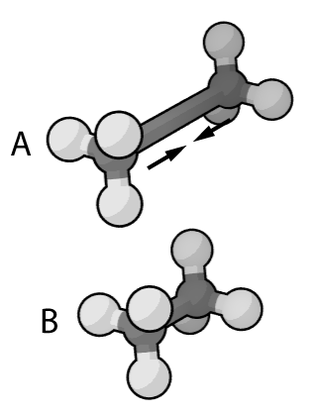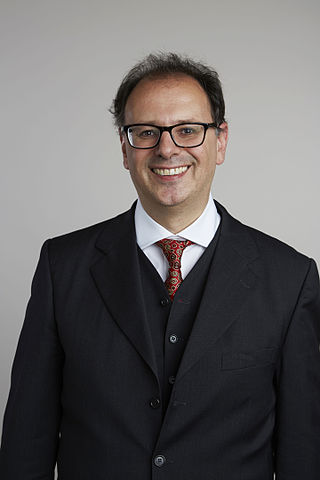Related Research Articles

Donald Lynden-Bell CBE FRS was a British theoretical astrophysicist. He was the first to determine that galaxies contain supermassive black holes at their centres, and that such black holes power quasars. Lynden-Bell was President of the Royal Astronomical Society (1985–1987) and received numerous awards for his work, including the inaugural Kavli Prize for Astrophysics. He worked at the University of Cambridge for his entire career, where he was the first director of its Institute of Astronomy.

An ionic liquid (IL) is a salt in the liquid state at ambient conditions. In some contexts, the term has been restricted to salts whose melting point is below a specific temperature, such as 100 °C (212 °F). While ordinary liquids such as water and gasoline are predominantly made of electrically neutral molecules, ionic liquids are largely made of ions. These substances are variously called liquid electrolytes, ionic melts, ionic fluids, fused salts, liquid salts, or ionic glasses.

Denis James Evans is an Australian scientist who is an emeritus professor at the Australian National University and honorary professor at The University of Queensland. He is widely recognised for his contributions to nonequilibrium thermodynamics and nonequilibrium statistical mechanics and the simulation of nonequilibrium fluids.

In the context of chemistry, molecular physics, physical chemistry, and molecular modelling, a force field is a computational model that is used to describe the forces between atoms within molecules or between molecules as well as in crystals. Force fields are a variety of interatomic potentials. More precisely, the force field refers to the functional form and parameter sets used to calculate the potential energy of a system on the atomistic level. Force fields are usually used in molecular dynamics or Monte Carlo simulations. The parameters for a chosen energy function may be derived from classical laboratory experiment data, calculations in quantum mechanics, or both. Force fields utilize the same concept as force fields in classical physics, with the main difference being that the force field parameters in chemistry describe the energy landscape on the atomistic level. From a force field, the acting forces on every particle are derived as a gradient of the potential energy with respect to the particle coordinates.

The Fritz Haber Institute of the Max Planck Society (FHI) is a science research institute located at the heart of the academic district of Dahlem, in Berlin, Germany.

Daan Frenkel is a Dutch computational physicist in the Department of Chemistry at the University of Cambridge.
Sir William Cecil Dampier FRS was a British scientist, agriculturist, and science historian who developed a method of extracting lactose from whey.
Martini is a coarse-grained (CG) force field developed by Marrink and coworkers at the University of Groningen, initially developed in 2004 for molecular dynamics simulation of lipids, later (2007) extended to various other molecules. The force field applies a mapping of four heavy atoms to one CG interaction site and is parametrized with the aim of reproducing thermodynamic properties.
Frank H. Stillinger is an American theoretical chemist and a namesake of the Lubachevsky–Stillinger algorithm. He has recently collaborated with research groups as a senior scientist at Princeton University.

Ali Alavi FRS is a professor of theoretical chemistry in the Department of Chemistry at the University of Cambridge and a Director of the Max Planck Institute for Solid State Research in Stuttgart.

Roger Arthur Sheldon is a British chemist who is emeritus professor of Biocatalysis and Organic Chemistry at Delft University of Technology in the Netherlands.

Klaas Wynne is a professor in the School of Chemistry at the University of Glasgow and chair of Chemical Physics. He was previously a professor in the Department of Physics at the University of Strathclyde (1996–2010).
Florian Müller-Plathe is a German theoretical chemist and professor for theoretical physical chemistry at Technische Universität Darmstadt.
Teresa Lyn Head-Gordon is an American chemist and the Chancellor's Professor of Chemistry, Bioengineering, and Chemical and Biomolecular Engineering at the University of California, Berkeley. She is also a faculty scientist in the Chemical Sciences Division at the Lawrence Berkeley National Laboratory and a fellow of both the American Institute for Medical and Biological Engineering and the American Chemical Society (ACS).

Branka Maria Ladanyi was a Yugoslavian-born Croatian-American physical chemist, who spent her career in the department of chemistry at Colorado State University. Her research focused on structure and dynamics of liquids, broadly defined, which she studied using theoretical and computational techniques.

Amalie L. Frischknecht is an American theoretical polymer physicist at Sandia National Laboratories in Albuquerque, New Mexico. She was elected a fellow of the American Physical Society (APS) in 2012 for "her outstanding contributions to the theory of ionomers and nanocomposites including the development and application of density functional theory to polymers". Her research focuses on understanding the structure, phase behavior, and self-assembly of polymer systems, such as complex fluids polymer nanocomposites, lipid bilayer assemblies, and ionomers.

Elena Besley is a British scientist who is Professor of Theoretical and Computational Chemistry at the University of Nottingham. She holds a Royal Society Wolfson Fellowship and is Associate Editor of Nano Letters.
Susan Perkin is a British chemist who is a Professor of Physical Chemistry at the University of Oxford. Her research considers the physics of liquids and soft matter. She was awarded the 2016 Harrison-Meldola Memorial Prize and named the Soft Matter Lecturer of 2018. In 2015 Perkin was awarded a European Research Council starting grant and in 2020 she was awarded a European Research Council consolidator grant.
Michael W. Finnis is a British materials scientist who is Professor of Theory and Simulation of Materials at Imperial College London. He uses atomic-scale computation to understand atomic interactions, grain boundary embrittlement and open system thermodynamics. He was elected Fellow of the Royal Society in 2021, and awarded the Institute of Physics Dirac Medal in 2022.
Patricia Anne Hunt is a New Zealand chemist, and is a full professor at Victoria University of Wellington, specialising in ionic bonds in liquids. In 2024 Hunt was awarded one of two New Zealand Mana Tūārangi Distinguished Researcher Fellowships by the Royal Society Te Apārangi.
References
- 1 2 3 "'LYNDEN-BELL, Ruth Marion', Who's Who 2013, A & C Black, an imprint of Bloomsbury Publishing plc, 2013; online edn, Oxford University Press, Dec 2012".(subscription required)
- 1 2 3 "Fellows of the Royal Society | Royal Society" . Retrieved 7 January 2013.
- 1 2 3 "Women in Chemistry, Ruth Lynden-Bell | Department of Chemistry". www.ch.cam.ac.uk. Retrieved 7 August 2018.
- ↑ Lynden-Bell, Ruth M. (20 April 2021). "My Life in Changing Times: New Ideas and New Techniques". Annual Review of Physical Chemistry. 72 (1): 35–50. doi: 10.1146/annurev-physchem-090319-054423 . ISSN 0066-426X. PMID 33503383. S2CID 231758540.
- ↑ (19 May 2006). Royal Society Elections, University of Cambridge , Department of Chemistry, Theoretical Chemistry News Page. Retrieved 2 December 2010
- ↑ Awards to Individuals 2003, Leverhulme Trust . Retrieved 2 December 2010
- ↑ "Google Scholar".
- ↑ Ruth Lynden-Bell publications indexed by Microsoft Academic
- ↑ Del Pópolo, M. G.; Lynden-Bell, R. M.; Kohanoff, J. (2005). "Ab Initio Molecular Dynamics Simulation of a Room Temperature Ionic Liquid". The Journal of Physical Chemistry B. 109 (12): 5895–5902. doi:10.1021/jp044414g. PMID 16851642.
- ↑ Lynden-Bell, R. M.; Del Pópolo, M. G.; Youngs, T. G. A.; Kohanoff, J.; Hanke, C. G.; Harper, J. B.; Pinilla, C. C. (2007). "Simulations of Ionic Liquids, Solutions, and Surfaces" (PDF). Accounts of Chemical Research. 40 (11): 1138–1145. doi:10.1021/ar700065s. PMID 17914887. S2CID 2958411.
- ↑ Pinilla, C.; Del Pópolo, M. G.; Lynden-Bell, R. M.; Kohanoff, J. (2005). "Structure and Dynamics of a Confined Ionic Liquid. Topics of Relevance to Dye-Sensitized Solar Cells". The Journal of Physical Chemistry B. 109 (38): 17922–17927. doi:10.1021/jp052999o. PMID 16853300.
- ↑ Honorary Degree information from Queen's University Belfast
- ↑ Torney, Kathryn (6 July 2009). Queen's University of Belfast Graduations, The Belfast Telegraph . Retrieved 2 December 2010 ("Queen's University professor Emerita Ruth Lynden-Bell will be awarded Doctorates of Science for distinction in chemistry at a ceremony tonight.")